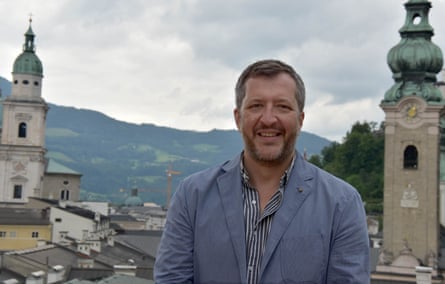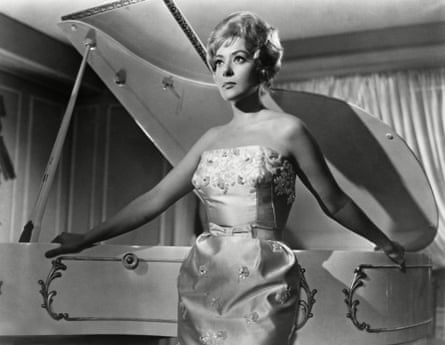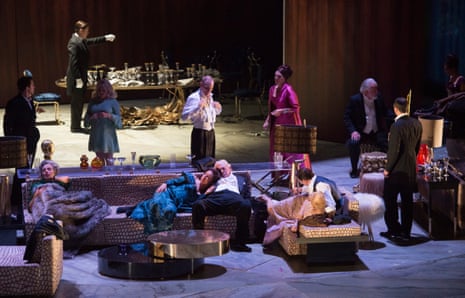“I’ve been eating a lot of lamb,” says Thomas Adès . “After what the sheep have put me through, I think I’ve earned the right.” The composer is at the Salzburg festival, preparing for the world premiere of The Exterminating Angel, his opera version of Luis Buñuel’s great surrealist film. On the day of their first “Schafeprobe” (sheep rehearsal), it seems that the real-life, flesh-and-wool ovines are not quite as happy on the opera stage as they are frolicking in alpine pastures. Never work with children or animals? This opera has both. Not to mention an untameable bear, a disembodied hand, a conductor who flies, and a burning cello.
The Exterminating Angel revolves around a grand dinner party that never ends. Its guests are trapped. What does it all mean? Well, at the start of the film, a caption says: “The best explanation of this film is that, from the standpoint of pure reason, there is no explanation.” But that hasn’t stopped every film critic since its appearance in 1962 attempting a psychological reading.
Why don’t the guests leave? There’s nothing physically stopping them: they just collectively come to the realisation that they can’t escape. What do the bear and the sheep symbolise? Are the film’s socially elite characters, marooned in their mansion while people outside protest and party, a metaphor for Franco’s Spanish regime, from whom Buñuel was in exile in Mexico when he made the film? And what about the ending? Finally free, the survivors go to church to mourn the guests who died, only for the congregation to find that the church doors are locked, and another pattern of hopeless entrapment looks set to repeat itself: it’s a terrifyingly resonant scene, but what does it all mean?
We’ll get to those enigmas, but the first thing I want to ask Adès is why do it at all? He says he originally had the idea 16 years ago – “but there were problems with the copyright, and then The Tempest got in the way”. He turned Shakespeare’s final play into an opera for Covent Garden in 2004, and sees connections between it and the world of The Exterminating Angel – and with Powder Her Face, his first opera, about the dazzling and grotesque life of the Duchess of Argyll, who was engulfed in sexual scandal in the 1960s.

“In a sense, this is a child of those two operas,” Adès says. Like the shipwrecked characters of The Tempest, the 15 inhabitants of the gilded cage of The Exterminating Angel are trapped in a place of magical enchantment and dramatic mayhem. Similarly, like the glittering high-society world of Powder Her Face, the dinner party guests are denizens of a cosseted but nightmarish world of aristocratic pretension. But as Adès composed and rehearsed, “that comparison has receded, and this opera is a very different animal. Probably a scarier animal.”
This opera is the latest and possibly most significant milestone in a career that has put Adès at the forefront of classical composers and conductors of his generation. Now 45, he has spent the last two-and-a-half decades dealing with the expectations that surround any composer touted as the Next Big Thing. And he has fulfilled them – by subversion. Adès’s music is a reinterpretation of the whole of musical history, or at least those bits that mean the most to him, from Couperin to Berlioz, from Beethoven to Gerald Barry. That vivid reimagining turns the familiar inside out, resulting in something surreally original.
This new opera is no different: it will sound unlike The Tempest and Powder Her Face, and not just because of its unusually huge cast of principals, all 15 of whom are on stage for the majority of the piece (a jaw-dropping lineup of operatic talent, from the youthful Iestyn Davies and Sophie Bevan to vastly experienced vocal royalty such as John Tomlinson and Anne Sofie von Otter). But also because of the distinct soundworlds Adès has found for The Exterminating Angel, taking in the otherworldly resonances of bells and ritualistic Spanish drumming.
These are precisely calculated references, shedding light on Adès’s interpretation of Buñuel’s story. For Adès, the essential misinterpretation of The Exterminating Angel is that it is surrealistic. It does seem an easy enough assumption to arrive at, given that the film is made by the father of cinematic surrealism (Buñuel’s razor-blade across the eyeball in Un Chien Andalou, his 1929 film with Salvador Dalí, is the defining image of early avant-garde cinema). But Adès says: “Actually, it’s completely realistic. Once you’ve been working on it, what it means becomes obvious.”
I’m waiting with bated breath. “To me, the question Buñuel is asking isn’t ‘Why don’t they leave?’ but ‘Why do they want to leave?’ What is it that makes any of us want to do anything, change anything, go from one room into another? And in the absence of that desire to change or to move, which Buñuel switches off in his characters, it’s like the Terminating Angel.” By this, he means that the characters reach a terminus, their lives put on hold. “And that can only become the Exterminating Angel, an angel of doom and death.”

So what about the bells and drums? Adès describes the former as “an intrusion of eternity into everyday time. When bells start to ring, you have to stop what you’re doing. You could understand bells as saying, ‘Here we are again – and you’ve still done nothing! Nothing has changed!’” That certainly chimes with the characters in The Exterminating Angel, fated to their unchanging dining room, but the bells are also meant to resonate with Salzburg. “This place is the capital of bells!” says the composer. “Every second building has a massive bell that goes off all the time. Some of them play whole chunks of Mozart arias. And it feels like a place where very little changes.”
The drums, meanwhile, are a nod to Buñuel’s own life. He was born in Calanda in Spain, where “they have a drumming festival every year, where everyone in the town drums the same simple but unusually long rhythmic pattern. They drum without stopping for three days. That’s an experience that disturbs time, making it stand still. It’s like an end point to whatever was started by the bells.”
With dark humour, Adès says the part he would most like to play in the opera is Russell, who seems to embody the story’s prophetic elements. “He passes out at the end of act one and spends all of the next act groaning on the sofa. Then suddenly he struggles up and says, ‘I am so happy I won’t see the extermination.’” And extermination, thinks Adès, really is the name of the game. “It’s about the end of the world – it’s very catastrophic. But then it’s made by Buñuel, who had seen such catastrophic things in the Spanish civil war, the destruction of the whole order.” He pauses. “We don’t get that so often in Britain – although it might be happening now.”
Adès’s score does not have the double-bar line that conventionally symbolises the conclusion to a piece of music. Instead, it is open-ended, as if we’re all doomed to repeat this cycle, over and over. “It never ends,” Adès says. “Isn’t that awful? Dreadful, really.”
Now that the sheep rehearsal is out of the way, I ask Adès if they’re having bear rehearsals too. They are – but the bear won’t be a real-life animal, endangering the cast and the audiences at the festival, but some kind of simulacrum. Buñuel used an actual bear. “It climbed the walls,” says Adès. “But it wasn’t planned. Buñuel directed that scene with a rifle: if it decided to attack someone, he was going to shoot it. The days when you could get away with that are no longer with us.” He pauses again. “Alas! Imagine – conducting with a rifle.”

Comments (…)
Sign in or create your Guardian account to join the discussion